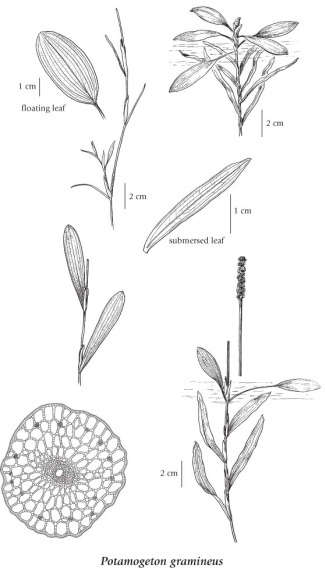Potamogeton gramineus L.
grass-leaved pondweed (variableleaf pondweed)
Potamogetonaceae (Horned pondweed family)
Introduction to Vascular Plants
grass-leaved pondweed (variableleaf pondweed)
Potamogetonaceae (Horned pondweed family)
Introduction to Vascular Plants
Species Information click to expand contents
General:
Perennial, aquatic or semi-terrestrial herb from strong rhizomes; stems up to 150 cm long, freely branched, nearly circular in cross-section, tapered.
Leaves:
Submersed leaves narrowly lanceolate, thin, flat, green, 2-7 cm long, 0.5-2.5 cm wide, unstalked, not clasping the stem, the tips rounded or pointed, the stipules 0.5-3 cm long; floating leaves markedly different from the submersed ones, lanceolate to elliptical, thick and leathery, 2-10 cm long, 1-4 cm wide, long-stalked, the tips pointed, tapering at the bases.
Flowers:
Inflorescence spikelike, the spikes 1-2.5 cm long, with 5 to 10 whorls of flowers, the stalks thin.
Fruits:
Achenes, almost globe-shaped, 1.7-2.5 mm long, 1.6-2 mm wide, the beaks short, the keels sharp and prominent.
Notes:
Stem anatomical characters Interlacunar bundles present in 1 circle, subepidermal bundles present or absent, pseudoepidermis absent or 1 cell thick, endodermis of U-cells. A highly variable species with several varieties described in N America based on stem branching and size of submersed leaves (e.g. var. maximus Morong ex A. Benn., var. myriophyllus Robbins). Their taxonomic recognition is questionable. Potamogeton gramineus hybridizes with P. natans and without examining stem anatomical characters, this hybrid (P. sparganiifolius Laest. ex Fries) can easily be misidentified as P. nodosus.
Illustration click to expand contents

If more than one illustration is available for a species (e.g., separate illustrations were provided for two subspecies) then links to the separate images will be provided below. Note that individual subspecies or varietal illustrations are not always available.
Illustration Source: The Illustrated Flora of British Columbia
USDA Species Characteristics click to expand contents
Flower Colour:
Green
Blooming Period:
Late Spring
Fruit/Seed characteristics:
Colour: Brown
Present over the Summer
Source: The USDA
Ecology click to expand contents
Ecological Framework for Potamogeton gramineus
The table below shows the species-specific information calculated from
original data (BEC database) provided by the BC Ministry of Forests and Range.
(Updated August, 2013)
The table below shows the species-specific information calculated from
original data (BEC database) provided by the BC Ministry of Forests and Range.
(Updated August, 2013)
| Site Information |
Value / Class |
||
|
Avg |
Min |
Max |
|
| Elevation
(metres) |
833 | 110 | 1230 |
| Slope
Gradient (%) |
0 | 0 | 0 |
|
Aspect (degrees) |
0 | ||
| Soil
Moisture Regime (SMR) [0 - very xeric; 4 - mesic; 8 - hydric] |
7 | 6 | 8 |
| Modal
Nutrient Regime
Class |
D | ||
| #
of field plots species was recorded in: |
48 | ||
| Modal
BEC Zone Class |
IDF | ||
|
All BEC Zones (# of stations/zone) species was recorded in |
BG(1), BWBS(1), CDF(2), CWH(14), ICH(5), IDF(17), SBPS(6), SBS(2) | ||
|
Source:
Klinkenberg 2013
|
|||
Habitat and Range click to expand contents
Lakes, lake margins, ponds in peat bogs, ditches and slowly flowing streams and rivers in all but the alpine zone; frequent throughout BC; circumpolar, N to AK, YT and NT, E to NF and S to ME, MA, PA, WV, OH, IN, IL, IA, NM, AZ and CA; Eurasia.
Status Information click to expand contents
Synonyms click to expand contents
Synonyms and Alternate Names:
Potamogeton gramineus
Potamogeton gramineus
Potamogeton gramineus var. graminifolius Fr.
Potamogeton gramineus var. maximus Morong
Potamogeton gramineus var. myriophyllus J.W. Robbins
Potamogeton gramineus var. typicus Ogden